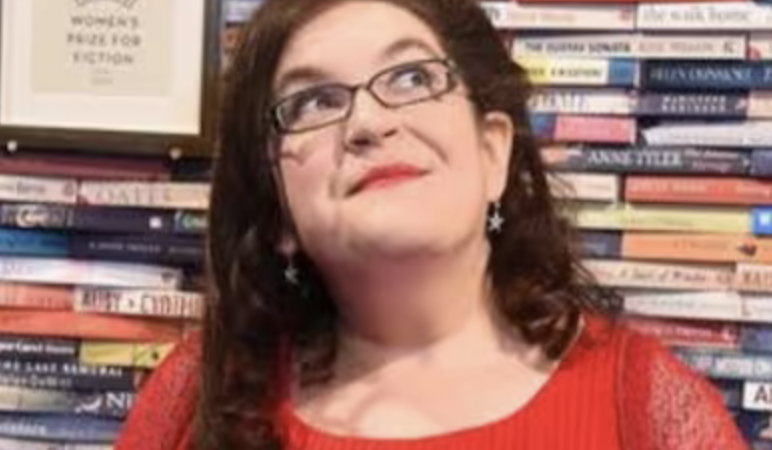On my first night in the jungle in Panama, I spotted blue reflective glints on the ground. I was making my way back to my tent by the light of my head torch. As I turned, there they were—among the leaves and debris—gleaming with a profound bright turquoise. What were they? Drops of rain or dew? Some sticky, blue-tinged sap excreted by one of the many millions of plants I knew nothing about? I’d already seen the nests—like clay bags hanging from branches—of the oropendola bird, whose call sounds precisely like someone dropping a marble into a bucket of water: plop-sploosh. Who knew what other wonders awaited me? Fascinated, I knelt down in my long, mosquito-proof trousers and brought my head closer to one of the bright-azure reflectors. And then I saw it. Each of those thousands of tiny blue reflective glints was…a set of spider eyes. I double-checked the insect-proof zip on my tent every night after that.
I was incredibly lucky—in so many ways—that I was travelling with Margaret Atwood. She is at home in wild nature: her father was a Canadian Forestry Board entomologist. She had suggested this birding trip to Darién with the extraordinary company Naturalist Journeys. When I told her about the spiders the next day, she immediately got out her own torch to have a good look. No matter how much you know about the wild, there’s always more to learn. And it was certainly on that trip to Panama that my new novel The Future started to germinate.
Germination and other plant metaphors are extremely apt. The jungle teems with life. I had heard that before, but until I was actually there, I couldn’t imagine what it meant. Everywhere you look is alive. The ground throngs with beetles, millipedes, and plants: seemingly dozens of species in every square inch. The trunks of the trees are covered in mosses that are themselves full of tiny insects; the sky is filled with birds.
At dawn and dusk, the chorus is almost too loud to speak over. At night, the howler monkeys crash through the jungle. I had previously experienced nature as calm and quiet. It was in Darién that I realised that what I’d thought of as ‘nature’ is the denuded, half-dead, withered agricultural landscape of the United Kingdom. Pretty fields and manicured gardens are all very well, but they’re not wild nature.
What I felt, when I realised this, was grief. I’m in my mid-forties now, and even the pockets of nature I remember from my suburban London childhood—scrubland next to the Tube lines, picking wild blackberries, hedgehogs in the garden at night, sometimes with their hoglet young, little prickly buttons—are gone. According to the WWF, the UK is one of the most nature-depleted countries in the world.
How has it happened? I’m a novelist concerned with power. I am interested in the forces—seen and often unseen—that shape us, make us do certain things, and believe things even about ourselves without our truly being aware of them. We thought our abundant natural world would always be there. We got excited about looking at our screens—and there was a lot of money to be made convincing us not to look away.
We mistook a text-prediction tool for ‘artificial intelligence’. A virtual companion cannot make up for the lost companionship of the natural world. Listen, I love technology. It’s just that its place is to enrich our
lives, not to replace them.
Around the time I was in Darién, I read that technology billionaires had built themselves survival bunkers so that they don’t need to live through a climate or environmental disaster with us. This struck me as a doctrine of despair. If the richest people on the planet have these bunkers, it means they have no need to try to make it better for the rest of us. That’s how power works.
My novel The Future opens as the billionaires receive an alert from their AI systems: a disaster is coming, it’s time to leave for the bunkers. It doesn’t work out as they expected. The book is a love story, a nourishing thriller and a kind of heist: can power be taken from the hands of these few people and used to save the natural world for the rest of us? I wanted—I found—to write something hopeful. I’m sick and tired of despair. Nature never despairs: it just keeps on living and striving. I want to think about what can be done, not sit in the ashes and weep.
I think Margaret Atwood knew that this trip would be a revelation to me: she joked that trying to show me rare bird species was like trying to show a magic trick to a four-year-old: the child doesn’t know there’s not supposed to be a rabbit in a hat. You have to understand what it’s supposed to be like to see the difference. I had no idea what the UK was missing until I went to Panama. When I got back to Panama City, there was a minor earthquake. But the earthquake had already happened within my mind: silent, upon a peak in Darién.
Purchase the book here on Amazon: https://www.amazon.com/Future-Naomi-Alderman/dp/166802568X?&linkCode=ll1&tag=adrianprozzo-20&linkId=6f9fb184cc3ae4f8c7daa9c495f1ffd4&language=en_US&ref_=as_li_ss_tl
